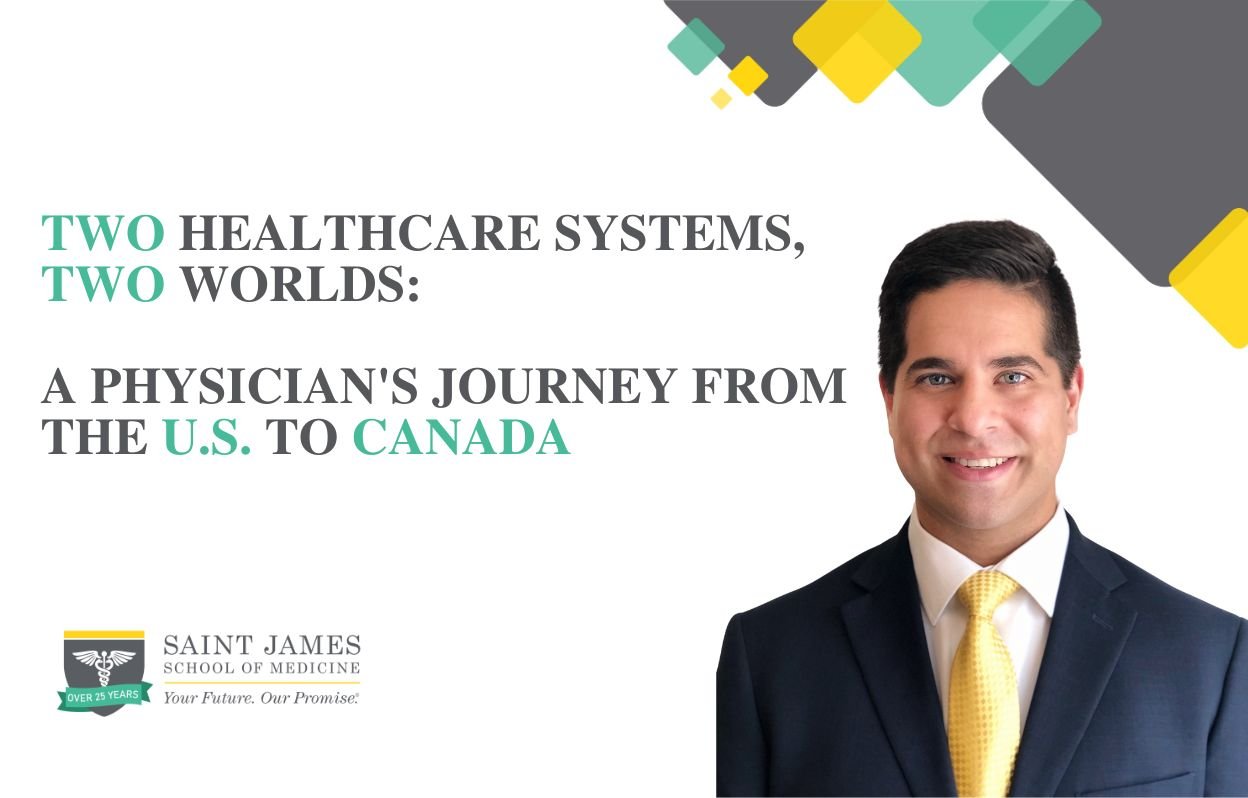
The world of medicine may seem unified in its pursuit of health and healing, but the healthcare systems in which doctors operate couldn’t be more different. The contrast between privatized and nationalized healthcare isn’t just theoretical—it’s real, and it’s shaping the careers of doctors and the lives of their patients in profound ways.
Dr. Ivan Escudero, an alumnus of the St. James School of Medicine, experienced this contrast firsthand. Having completed his residency in the United States and later starting his own clinic in Canada, he’s had a rare opportunity to work within both the U.S. privatized healthcare system and Canada’s nationalized model. His journey highlights not just the personal impact these systems have on physicians but the far-reaching consequences for the patients they serve.
The Reality of Privatized Healthcare: Red Tape and Burnout
For many, the U.S. healthcare system represents the pinnacle of innovation and opportunity. It’s a place where doctors can, theoretically, rise through the ranks, establish successful practices, and benefit from the high salaries and career independence that come with privatized healthcare. But the reality is often more complex, as Dr. Escudero discovered.
“Owning your own clinic in the U.S. is almost a thing of the past,” he explains. “Physicians are at the mercy of insurance companies, and the bureaucracy is overwhelming.”
In the U.S., the presence of multiple insurance companies creates layers of red tape that often take up a significant portion of a physician’s time. Simple procedures like prescribing insulin can turn into a mountain of paperwork, requiring prior authorization just to ensure that patients receive essential medication. This administrative burden leaves doctors feeling powerless, frustrated and burnt out.
As a result, many doctors in the U.S. find themselves working under large hospital systems or becoming part of large physician groups. The freedom to run an independent practice is increasingly rare, replaced by the constant battle with insurance companies over patient care and reimbursement. It’s a system where patient needs often clash with corporate priorities, and physicians are left stuck in the middle.
Nationalized Healthcare in Canada: Simplicity, but at a Cost
In contrast, Dr. Escudero found Canada’s healthcare system to be less bureaucratically heavy. “In Canada, everything is much simpler. You deal directly with the government, and there’s far less red tape compared to the U.S.,” he shares.
Yet, simplicity comes at a cost. While Canadian physicians don’t face the same level of interference from insurance companies, they also grapple with other limitations—most notably, the shortage of specialists and long waiting times for certain procedures.
“In Canada, millions of people don’t have a family physician, and accessing specialists can take months,” says Dr. Escudero. “In rural areas, the scarcity of resources can be staggering. As a family doctor, I often act as both a general practitioner and a specialist for my patients, which puts enormous pressure on me and the healthcare system.”
Unlike the U.S., where patients can often “shop” for specialists and healthcare providers, Canadians are limited by availability. While this nationalized system ensures that everyone receives care, the quality and speed of that care can be compromised by resource limitations.
The Psychological Impact on Physicians
For Dr. Escudero, navigating these two systems wasn’t just a professional challenge—it was a deeply personal experience that shaped his outlook on medicine. In the U.S., the high-stakes environment pushed him to his limits but also left him feeling drained.
“The U.S. system can be soul-crushing,” he admits. “Yes, you can make a lot of money, but the administrative burden is so high that you sometimes forget why you became a doctor in the first place.”
In contrast, his work in Canada has allowed him to focus more on patient care and less on battling with insurance companies, but the systemic shortages come with their own set of challenges.
Lessons for the Next Generation of Physicians
Dr. Escudero’s story provides valuable lessons for medical students and aspiring doctors, particularly those weighing the decision of where to practice. For students at the St. James School of Medicine and elsewhere, it’s important to remember that healthcare is not just about treating patients—it’s about navigating the systems that control access to care.
For those entering the U.S. system, Dr. Escudero advises being prepared for the bureaucracy that comes with privatized care. “You’ll be spending a lot of your time managing insurance claims, arguing with companies about what treatments are ‘necessary,’ and making sure you get reimbursed for your work. It’s exhausting, but it’s the reality.”
On the other hand, those looking to practice in Canada or other nationalized systems should be ready to work in environments where resources are stretched thin and waiting lists are long. “In Canada, it’s not unusual for patients to go without a family doctor for years. As a doctor, you have to be resourceful and prepared to take on many roles.”
Striking a Balance
At the end of the day, no system is perfect. Both the U.S. and Canada have their advantages and disadvantages, but for physicians like Dr. Escudero, the key is finding balance—between the need to provide quality care and the practicalities of working within complex healthcare systems.
Whether you’re a medical student preparing to enter the field or a seasoned physician navigating the daily grind, Dr. Escudero’s journey serves as a powerful reminder of the complexities of modern healthcare and the resilience required to succeed in today’s medical world.
To learn more about pursuing a career in medicine, visit Saint James School of Medicine for insights, resources, and opportunities to start your own medical journey.
